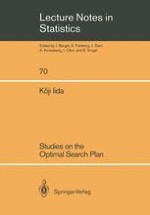1992 | OriginalPaper | Buchkapitel
Forestalling Detection in Two-Sided Search
verfasst von : Kōji Iida
Erschienen in: Studies on the Optimal Search Plan
Verlag: Springer New York
Enthalten in: Professional Book Archive
Aktivieren Sie unsere intelligente Suche, um passende Fachinhalte oder Patente zu finden.
Wählen Sie Textabschnitte aus um mit Künstlicher Intelligenz passenden Patente zu finden. powered by
Markieren Sie Textabschnitte, um KI-gestützt weitere passende Inhalte zu finden. powered by
In this chapter, we will investigate a forestalling detection problem in a two-sided search situation. At present, studies of the two-sided search problem are classified into two types, the hide-and-search problem and the evasion-and-search problem. In the hide-and-search problem, the target hides itself, selecting a point in the target space and stays there inactive during the search. A searcher wants to find the target efficiently, whereas the target does want not to be found. Usually, the game theoretical approach is taken and the optimal strategies for both sides are sought. The works of Neuts (1963), Johnson (1964), Danskin (1968), and Gittins and Roberts (1979) are the studies of this category. In the evasion-and-search problem, the target is assumed to be able to evade the searcher, observing the searcher’s current position during the search. The problem is formulated as a sequential multistage search game. Norris (1962), Sakaguchi (1973), Washburn (1980b), and Nakai (1986a) investigated this problem. Nakai (1986b) considered a search game in which two searchers compete with each other in detecting a stationary and unconscious target.
